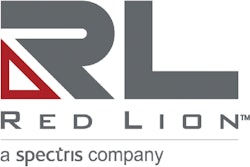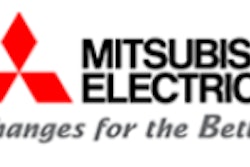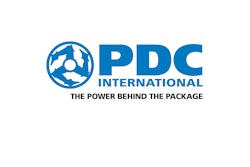PDC International is well known and highly regarded as a maker of decidedly robust tamper-evident neck-banders/shrink sleeve labelers. But management recently issued a challenge to the firm’s engineers: Build a moderate-speed machine that has a smaller footprint and that costs 30% less than PDC’s comparable machines. “Voila,” said the engineers, “meet the 60 Evolution Series Shrinksealer.”
Predictably enough, servo components play a key role in PDC’s new machine, which has a rated speed to 170 containers/min. One servo activates the timing screw infeed that meters containers into the application station. The other servo activates the neck-band feed. Both are MR-E Series motors from Mitsubishi. Also supplied by Mitsubishi are the FX3U-Series PLC, the variable frequency drive that serves as the machine’s main drive, and the HMI.
“This is our first experience with Mitsubishi, and one of the things we like is that they offer such a full line,” says PDC electrical engineer Rich Doran. “In the past we might have gotten the PLC from one supplier, a variable frequency drive from another, a servo motor from a third, and HMI from a fourth. It’s nice having one vendor handle them all.”
One reason the controls package allowed PDC to build a less costly machine is because a number of mechanical linkages are now eliminated. For example, a more traditional PDC machine in this class would have a main drive that was connected to the neck-band feed and to the timing-screw infeed by belting. Not only does the belting add cost and require that the machine be larger. It also means that the synchronization of the main drive, the neck-band feed, and the timing-screw infeed is only as good as a belt-based, mechanical connection can be. Servos synchronize better.
In the 60 Evolution Series, the system’s main drive, a VFD from Mitsubishi, drives a Baldor inductive motor that has a Red Lion (www.redlion.net) encoder on it. The encoder sends position information to the PLC. Once the PLC knows where the main drive is in its 360-degree rotation, it commands the two servo motors to synchronize their motions with the position of the main drive. It’s yet another example of an ongoing trend: mechanical cams replaced by electronic camming. The net result is that bottle infeed and neckband feed are always perfectly synchronized with the machine’s main drive.
“Once the machine operator selects the machine speed at the HMI, the main drive knows what frequency to run at,” says Doran. “The encoders and the PLC take care of the rest. The PLC even handles pulse and direction outputs, which means the machine can handle printed neck bands that have to be fed, cut, and applied in register. The PLC can do a registered move. That functionality is built right into the PLC, so we don’t need a separate indexing servo motor.” A third axis of motion controlled and synchronized by the PLC is the IMS stepper motor on the film unwind. “We get all the functionality we need in a less expensive PLC,” says Doran. “This really helps broaden our line.”

























